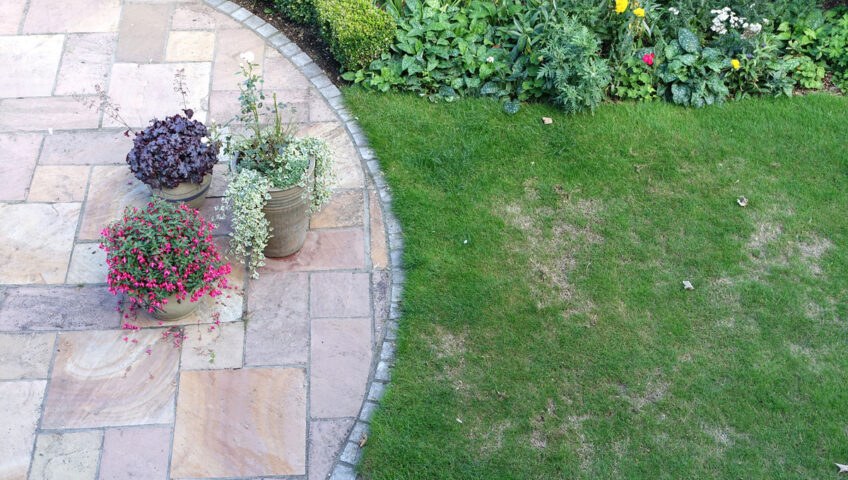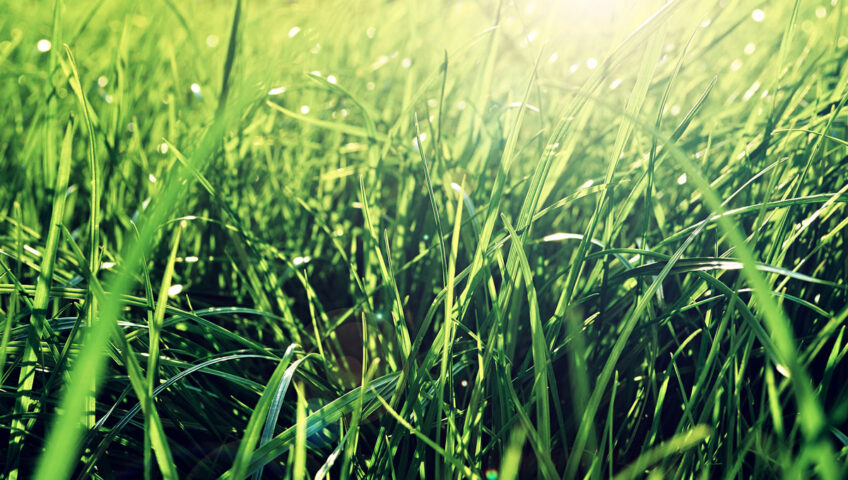Brown Patch
IRREGULARLY SHAPED TAN LEAF LESIONS WITH RED MARGINS; ROUGHLY CIRCULAR BROWNISH PATCHES IN TURF
Brown Patch disease shows up as reddish-brown patches in lawns. Grass blades within or near the affected area will have tan colored, irregular shaped lesions with a reddish margin. Fungicides may be needed to reduce the disease infestation. Also, to aid recovery, maintain consistent growth; not too slow and not too fast. Try to keep grass growing about 1 to 1.5” per week. If it is below that, a summer fertilization is recommended; especially if the lawn is less than 10 years old. Water in the mornings when the wind is calm, humidity is high, and evaporation rates are lowest. Know that turfgrass does not need, and will not benefit from, “cooling” irrigation (syringing) in the afternoons.
Turf Dormancy
KENTUCKY BLUEGRASS VS. TALL FESCUE
A tall fescue lawn should NOT be allowed to go dormant as it is not likely to recover. Kentucky bluegrass (KBG) can be allowed to go dormant for a short period to conserve water. Why the difference? KBG physiologically has the ability to go dormant (turn brown but still be alive) to escape drought conditions during hot, dry summers. On the other hand, tall fescue tolerates drought due to a much deeper root system but cannot physiologically go dormant to avoid drought. If tall fescue turns brown, it is likely dead. Due to a deeper root system that uses soil moisture deeper in the profile, tall fescue does require less frequent irrigation than shallow-rooted Kentucky bluegrass.
If a homeowner chooses to let KBG to go dormant, remind them that during very hot, dry conditions, the lawn may need about ¼” of water a week to moisten crowns; and KBG can remain dormant for about 4 to 5 weeks only. If fall conditions remain hot and dry, irrigation should resume.
Yellow Lawns & Iron Chlorosis
WEATHER CONDITIONS FAVOR DENITRIFICATION AND YELLOWING OF TURFGRASS
While summer yellowing of Kentucky bluegrass & Tall Fescue lawns is due to iron chlorosis, the chlorosis is believed to be caused not only by high pH soil but also by a root dysfunction from hot and/or wet soils. Iron chlorosis will NOT respond to an application of nitrogen. When yellowing occurs, apply an application of iron, such as iron sulfate.
Eastern Red Cedar and Juniper Browning
MAY HAVE A VARIETY OF CAUSES
Cercospora blight is a fungal disease that will cause browning from the bottom of the tree up and from the inside of the branches out. If this disease is confirmed, applications of Bordeaux mixture or a liquid copper fungicide such as Tenn-Cop 5E will effectively control this disease. At least two applications are needed for good control. The first application should just prior to initial infection (June/July). The second treatment should be made during the last half of July through mid-Aug. The second application normally gives good protection against infection for the remainder of the season. However, additional applications may be necessary during periods of frequent rains.
Turfgrass watering
ENCOURAGE CUSTOMERS TO USE CORRECT IRRIGATION PRACTICES PROMOTE TURFGRASS HEALTH
Watering turf wisely during mid-summer is especially important to promote a healthy turf, reduce insect and disease pressure, and conserve a natural resource. It is much better to stay on the dry side than to over-water. Excess moisture in the root zone reduces soil oxygenation, increases soil heat retention, and increases disease risk.
Some broad advice to help avoid all of these issues:
- Make sure your irrigation systems are working correctly
- Adjust irrigation schedule according to weather conditions
- Know how much water each irrigation system puts out
- Don’t over water
- Resist the temptation to syringe turf (water in afternoon to “cool off” turf)
Thank you for your business, please get in touch if you have any questions or concerns!
LibertyLawn@gmail.com / 402.423.0061
3810 Cornhusker Hwy, Lincoln, NE 68504 / PO Box 29442. Lincoln, NE 68529






